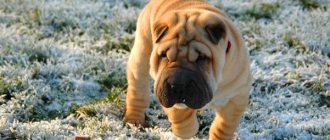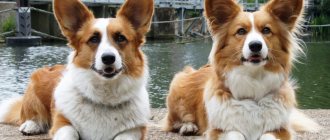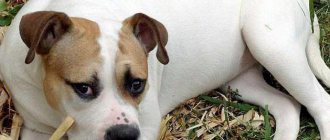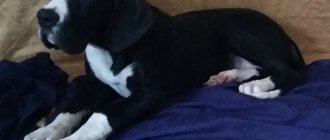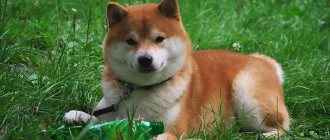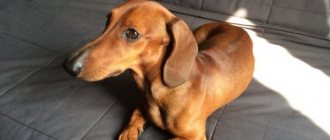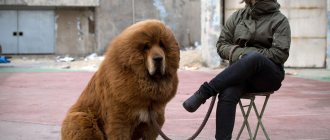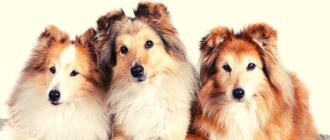Miniature Bull Terrier puppies!
Litter starting with the letter "F" kennel "Iz Constellation Adomas" mini bull terriers! TWO GIRLS AND A MALE ARE AVAILABLE FOR RESERVATION!
Birthday 11/12/2021
LOOK
07/21/2021 miniature bull terrier puppies were born, litter starting with the letter “T”!!!!
ALL PUPPIES SOLD!
All puppies on the link: >>> VIEW
Dad: Ansgar Freya Walter for the Adomas Constellation!
titles:
Junior Champion of Russia Junior Champion of RKF
Mom: Lori'El from the Adomas Constellation!
LITTER "P" miniature bull terrier puppies!!!
All puppies are sold!
Pippi from the Constellation of Adomas (3.5 months)!
Birthday: 08/14/2019 minibuli puppies were born!
History of the Mini Bull Terrier breed
Miniature and standard bull terriers have common ancestors and remain their closest relatives.
Basically, the breed was bred by selection, since litters of standard bull terriers always produced puppies that differed from their counterparts in their more modest dimensions. At first, undersized animals were regarded as breeders, until British breeders came up with the idea of forming them into an independent breed. In 1914, tiny dogs, dubbed Toy Bull Terriers, were first shown at a London exhibition. True, further breeding work came to a standstill: enthusiasts who began to breed animals were confused by the fact that dwarf individuals produced defective offspring, and even with a bunch of genetic ailments. Having worked on the mistakes, the breeders decided not to get carried away with extreme characteristics and bred slightly larger dogs, inferior in size to standard bull terriers, but superior in size to toy dogs. Representatives of this species were called miniature bull terriers.
In 1938, the Mini Bull Terrier Club began its work in Great Britain, and just a year later the breed received recognition from the English Kennel Club. It is also worth noting the fact that the dogs bred in this time period were standardized not by weight, as was done previously, but by height. In America, the first “fan club” of the breed opened in 1966, but miniature relatives of standard bull terriers began to be registered with the AKC only in 1991.
Miniature Bull Terrier puppies
Animals entered Russia in the 90s, when fighting dogs became popular among crime bosses. It’s not that bull terriers were particularly bloodthirsty, but due to their specific appearance they immediately became in demand. As for the mini-bull terriers themselves, they, first of all, charmed the owners of Russian standard apartments. There was not much space in such housing, so the minibull became an excellent “compromise” for dog lovers who want to have a menacing-looking, but at the same time undemanding pet.
Nutrition
Dogs of this breed are characterized by a tendency to gain excess body weight, in other words, obesity. The weight of a miniature bull terrier , if we are talking about an adult, should not exceed 15 kg.
Owners are under no circumstances recommended to feed their pet from their table. In addition, it is important to monitor portion dosages. It’s good if the dog receives factory products, and it should be of the premium or extra-premium category.
In this case, manufacturers have already calculated the balance, as well as the amount of microelements and vitamins, and prescribed the dosage of servings on the packaging, based on the size and age of the dog.
Miniature Bull Terrier Puppy
If the dog receives natural products, then the owners themselves must calculate the required number of grams, and also include vitamin supplements in the diet. Miniature Bull Terrier puppies eat up to 6 times a day; with age, the number of feedings per day decreases and by 9-10 months the dog can be switched to a two-time diet.
It is important to ensure that there is no food left in the bowl after eating. In any case, 20 minutes after feeding, the dishes must be removed. But drinking water should be constantly available at any time of the year and day.
In addition, for dogs that eat natural foods, it is important to exclude sweets, flour, salty and fried foods from their diet. The basis should be meat and offal, fermented milk and vegetables. Sometimes you can give porridge.
Rice and buckwheat cereals are suitable. They are optimal for almost any breed, including those prone to obesity and allergies. It is important that the food is not only high in calories, but also easy to digest.
Mini Bull Terrier breed standard
Externally, the Miniature Bull Terrier is a smaller copy of the representatives of the standard line of the breed. Muscular, with strong bone structure and egg-shaped heads, minibulls are the type of super-charismatic pet that will always attract the attention of others. The lower height limit for a mini bull terrier is 35.5 cm. In this case, the dog can be slightly higher than the given level, but in no case lower. There are no weight restrictions for this breed, but it is imperative that the dog looks harmonious. Overweight and overly lean individuals will not make a show career.
Head
The deep, evenly filled head of the Miniature Bull Terrier is distinguished by its elongated profile and ovoid shape. The top of the skull is flattened, the surface of the muzzle is without depressions and excessively raised areas.
Nose
The bridge of the nose is curved downward at the tip. The nostrils are normally open, the lobe is evenly colored black.
Teeth and bite features
The lower jaw looks especially deep and prominent. Strong teeth stand in rows evenly, with the teeth of the upper jaw overlapping the lower ones, forming a complete scissor-shaped closure (bite).
Ears
The Mini Bull Terrier has thin and neat ears, located close to each other. The ear flap is in a vertical position, with the tips of the ears pointing straight up.
Eyes
The eyes of Mini Bull Terriers are characterized by a triangular shape, due to which they look very narrow and small. The iris is dark brown, often close to jet black. An important ratio: the distance from the eyes to the occipital protuberance should be less than from the nose to the eyes.
Neck
The beautifully arched and long neck of the Miniature Bull Terrier is covered with dense muscles. There are no folds. The base is noticeably thicker than the top of the neck, but the transition between them is smooth.
Mini bull terrier muzzle
Frame
All representatives of the breed have compact bodies with strongly curved ribs. The gap between the withers and the chest is very deep. The back is short, convex in the lumbar region and flat in the area behind the withers. The lower abdomen forms a smooth curved line, maximally selected in the groin area.
Limbs
The purebred mini-bull terrier stands confidently on strong, muscular legs, which are typical of a parallel stance. The length of the limbs and the depth of the chest have the same meaning (only for adults). The oblique shoulder blades, which are not overloaded, fit closely to the sides, forming right angles with the dog’s shoulders. The forearms are formed by strong rounded bones, the metacarpus are fixed in a vertical position.
The Mini Bull Terrier's hind legs are characterized by impressive hips, well-defined knee joints and strong shins. Hock joints with normal angles, metatarsals shortened but strong. The animal's paws are small, round in shape, and the toes are clearly curved. The Miniature Bull Terrier moves flexibly, without stiffness. When trotting, all four legs move synchronously; when accelerating, the paws are placed closer to the center.
Tail
The Mini Bull Terrier's short tail is set low. The tip of the tail is thin, the base is thick.
Wool
Short, moderately coarse hair has a pleasant shine. The breed's undercoat appears seasonally, more precisely, closer to winter.
Color
Mini Bull Terriers can be either completely white or colored. Solid white individuals may have spots on the head and pigmented skin. Colored bull terriers come in black and brindle, fawn, red and tricolor. Prohibited color options: speckled on a white background, brown-liver, blue.
Disadvantages and defects of the exterior
The list of defects in the external appearance of the breed is the same as that of standard bull terriers. Individuals with light eyes, speckled lobes, loose and folded skin, everted joints, long hair and non-standard colors cannot qualify for high exhibition ratings. Serious defects of the exterior also include cryptorchidism, depigmented skin of the nose, deafness and spots on the body of white dogs.
Marriage or breed?
Black color is considered the breed standard for bull terriers, however, there are practically no true black dogs of this breed.
Expert opinion
Kozhevin Semyon Kirillovich
Expert dog handler.
“Like other representatives of this breed, black bull terriers look very impressive: they have a strong, muscular physique, excellent reflexes and powerful jaws. However, one should not think that these dogs are characterized by increased viciousness towards people or animals. A properly raised Black Bull Terrier is a calm and balanced dog, distinguished by its friendly attitude towards its owners and its love for children. Such a pet will willingly accompany the owner during long walks, and, if necessary, will always protect him. When keeping these dogs, you need to take into account that black bull terriers, like other short-haired dogs, are not suitable for living in the yard of a private house or in an enclosure since they cannot tolerate either extreme heat or cold.”
Personality of the Miniature Bull Terrier
Mini-bull terriers have practically nothing left of their bloodthirsty ancestors, bred for dog fighting and rat-baiting. Today's representatives of the breed are positive, lively creatures who love outdoor games, running around and various pranks. Of course, they are not always good girls and are not averse to being stubborn in order to test the owner’s endurance for steadfastness, but aggression is not typical of the breed.
Mini bull terriers are completely unsuitable for the role of apartment watchmen. The most a dog can produce when a stranger approaches is a warning bark. However, this action occurs only when the pet is grossly provoked. The minibull hospitably greets friendly strangers on the threshold, trying to sycophantically lick their hand. But in relation to representatives of the fauna, the genes of brutal ancestors are still making themselves felt. For this reason, most dog management manuals strongly do not recommend letting your mini bull terrier off the leash during walks - the four-legged lawless dog will rush off after the first cat, pretending that he does not hear your shouts at all.
Do not keep domesticated rodents and a dog in the same area. In a permanent confrontation, only one person will survive, and this someone will definitely not be a hamster. To whom mini-bull terriers are able to make concessions are children. Firstly, because in their hearts they consider them stupider than themselves, and secondly, because it is kids who can satisfy the dog’s need for games. The worst test for the breed is loneliness. Minibulls, in principle, are not designed to while away the hours waiting for the owner, so for any single person with an irregular work schedule, the dog will quickly turn into a problem.
Advantages and disadvantages
pros
- Strong, resilient and energetic.
- Original appearance.
- Fearlessness and willingness to protect the owners.
- Intelligence and good learning ability.
- Loyalty to the owners.
- Calmness, balance and love for children.
- Friendly to the owners.
Minuses
- They can be aggressive towards other animals.
- They are rarely the instigators of fights, but if other dogs attack them, they will fight them to the death.
- They do not tolerate loneliness well.
- Jealous: they do not like to share the attention of their owners with other pets.
- They need friendly but firm treatment.
- They cannot do without great physical activity.
- Not suitable for keeping in a yard or enclosure.
From the first day of his appearance in the house, a black bull terrier must know his place and, if a growing pet is trying to take the place of leader, you need to gently but persistently let him understand that the boss in the house is the owner, and that the dog must obey him.
Education and training
Cynologists classify miniature bull terriers as highly intelligent, but difficult to train breeds. As a result: it is better to immediately lower the bar of requirements for “egg-headed meteors”. Take into account the fact that all representatives of this family are pronounced dominants who do not tolerate being harshly put in their place. In this regard, you will have to maintain a balance in the relationship, namely: show the dog that the leader in the house is still the boss, but at the same time avoid authoritarianism in communication.
It’s easy to motivate a minibull to perform great feats with praise and tasty bonuses, so for each successfully completed task the pet needs to be positively stimulated. You shouldn’t rely too much on the breed’s high intelligence either, so don’t be lazy in helping the dog while learning commands. For example, when giving the order “Sit!”, lightly press your hand on the animal’s back, forcing it to sit down on its paws.
It is better to present new techniques in an entertaining way: mini-bull terriers are also gambling addicts. But expecting perfect execution of commands from representatives of the breed is a pointless exercise. Miniature bull terriers do not have the perfectionism of service dogs, so accept the fact that your demands will not be fulfilled immediately and not exactly as you would like. It is advisable to demand perfect adherence to the rules only in everyday situations, when the comfortable life of others depends on the behavior of the pet.
As for special training programs, you won’t be able to “jump” above the UGS course with a miniature bull terrier. But with this friend you can practice sports disciplines. The breed is best at jogging behind the owner's bicycle, agility, and pitch and go. But weightpulling, which often involves standard bull terriers, will not work with their miniature relatives.
Ideally, the dog's training should be done by the head of the family. It is better not to try to involve children in this business: the minibull, of course, is not averse to fooling around with them, but this does not prevent him from considering the children a cut below himself. No physical punishment should be used against even a dog that has become quite nervous. If the dog is too loose, it is easy to rein him in with a stern look, taking away his favorite toy or depriving him of a delicacy that the pet was counting on. Just act in hot pursuit: it is useless to punish a minibull for torn wallpaper last week. The dog remembers the offenses just committed and has managed to forget about yesterday’s ones, so it will take your complaints as an unreasonable infringement of its rights.
Price
Before you buy a dog of this breed, you need to determine the purpose of the purchase. Prices for this breed are not low, which means that this investment can to some extent be considered an investment. The cheapest option is to buy a pet-class puppy. In this case, the owners will receive documents confirming their pedigree, as well as vaccination certificates.
But dogs of this class are not allowed to breed and participate in exhibitions. A puppy will cost even less if you buy it from someone else or on the market, but at best it will turn out to be a mixed breed, or even a completely mongrel dog, and a sickly one at that. If you plan to purchase in connection with further breeding, then there is no doubt: the money will pay off after three or four matings.
In this case, it is worth purchasing a breed-class dog. If the owners intend to take their pet to exhibitions and competitions, then we are talking about show class. In this case, the price of a miniature bull terrier can reach 120 thousand rubles and higher amounts.
In general, the breed is characterized as prone to genetic diseases, so the purchase must be approached with the utmost responsibility and caution, having first studied the parameters by which you can determine the healthiest representative.
Moreover, the trick is that at the time of sale the animal can be completely healthy, but in a couple of years it will die. But you can minimize the risk of buying an initially sick dog if you contact a miniature bull terrier nursery. These places offer the highest guarantees of purchasing a quality pet.
Another aspect is the nature of the animals. Minibulls are most suitable for calm people, experienced breeders with an active lifestyle. Beginners may find it difficult to deal with a dog that has cosmic stubbornness.
Maintenance and care
The miniature bull terrier is an ideal apartment dweller, capable of living happily even in limited space. It is important to understand that the breed is not decorative. To prevent a miniature bull terrier from tearing your home to pieces, you need to take him for a long and productive walk. It is ideal to combine walks with useful activities, such as sports exercises. During the season, you can take your minibull with you on a picnic or hunting - dogs love to chase game.
If sport and the pursuit of trophies are not suitable for some reason, you will have to think about how to unload the animal during a walk. The most popular options: harnesses with weights, jogging on loose sand and uphill. Don’t forget about toys: with them the miniature bull terrier takes his soul away at home, which helps him refrain from destructive games.
Important: sports, running with weights and other energy-consuming activities can be practiced no earlier than the puppy turns 8 months old.
Hygiene
If you want to save on groomer services and coat care products, the minibull is your dog. The smooth, short coat of the breed has dust-repellent properties, and the scanty undercoat that grows in winter never forms tangles. You don’t have to run after your animal with a comb either: to maintain a neat appearance, it’s enough to collect dead hairs from the dog’s body with a rubber glove or brush once or twice a week. However, smooth wool also has its disadvantages. For example, such a dog very poorly protects the minibull’s body from low temperatures, so for walking on frosty days you will have to get insulated overalls.
Short hair does not protect against insect bites, which can cause allergies. To prevent this from happening, use repellents and protective blankets when traveling with your dog into nature. Mini bull terriers should have their nails trimmed once a month. Be sure to monitor the health of your pet’s eyes - remove lumps of mucus that have formed in the corners of the eyelids with a clean cloth, which can be additionally moistened with chamomile decoction. Use hygiene drops or lotions to clean your ears weekly.
Feeding
The basis of the natural diet of mini bull terriers consists of lean meats (beef, rabbit, chicken), raw tripe, liver, low-fat fermented milk products and sea fish, cut into fillets. For safety reasons, the meat must first be frozen or doused with boiling water - this will help kill worm eggs and microorganisms that cause digestive problems. You can give buckwheat and oatmeal porridge, but you shouldn’t get too carried away with adding grains to your diet.
Miniature bull terriers benefit from any vegetables except legumes and potatoes, as well as fresh herbs. It is better to give these products raw and finely chopped. You can treat your pet to a boiled chicken egg 3-4 times a month. It is recommended to use special bran for dogs as a source of fiber. Before giving it to an animal, the bran must be soaked in kefir or broth and allowed to swell. Vitamin and mineral supplements are required when breastfeeding. Only mini bull terriers that eat commercial dry food do not need dietary supplements.
Character traits
Fighting dogs are an exclusive class of animals. They require a lot of attention and careful training. But bull terriers are not vicious, hateful dogs. On the contrary, behind powerful physical data there is a vulnerable soul hidden. The dogs have a restrained and balanced character. Pets become strongly attached to their owner and constantly strive to prove their love.
The appearance of dogs is original. Distinctive features:
- Height is about 60 centimeters, weight reaches 30 kg.
- Powerful, muscular body with flexible, athletic legs.
- Smooth short coat that does not require special care.
- Thin short ponytail.
- The muzzle is slightly elongated, the eyes are smart and good-natured, the forehead smoothly moves to the nose, which creates the image of a “dog in a muzzle.”
Bull Terriers are sporting animals . They need daily exercise and walks. It is necessary to diligently educate and train the dog. Without the proper enthusiasm of the owner, the pet easily becomes lazy and develops bad habits. If you are thinking about buying a Bull Terrier, be prepared to walk outdoors more often, for example, start jogging. A pet will be the best company for you.
Health and diseases of mini bull terriers
The breed is plagued by only three genetic diseases, all of which are inherited in an autosomal recessive manner, that is, when both parents are carriers of the defective gene. The most common ailment among miniature boules is primary lens luxation. The disease can be treated surgically, but is dangerous because in advanced stages it leads to complete blindness.
A very rare hereditary pathology is LAD, also known as lethal acrodermatitis, which manifests itself between the ages of 6 months and 2 years. A puppy with LAD is stunted in growth, suffers from diarrhea and patchy skin lesions on the face and paws. Sometimes carriers of the disease experience hyperkeratosis and lightening of the coat (with the exception of white individuals). Another hereditary disease of mini bull terriers is laryngeal paralysis. What is characteristic: pathology can manifest itself either on its own or due to mechanical damage to the throat (trauma, insect bites, tumors).
Possible diseases
The Minibull was genetically bred. This means that he is prone to hereditary diseases, which are sometimes difficult to detect at birth. They can manifest themselves during life and lead to a very sad outcome.
The weakest points of the Miniature Bull Terrier breed are the heart, ears and kidneys, and common ailments include aortic stenosis, tracheal hypoplasia, destruction of the kneecaps, as well as eye problems, such as lens dislocations.
Deafness is also considered a congenital defect, and it is more difficult to determine if only one ear is affected. The salvation can be the initial purchase of a dog with a good pedigree. Thanks to her, many diseases will be avoided.
Another vulnerable area is the skin, especially when it comes to white minibulls. These are various types of dermatoses and eczema. As a preventive measure, careful care of the epidermis using gentle products such as dry dog shampoos is recommended. If your dog doesn't have enough zinc in his diet, it will lead to a weakened immune system, resulting in nervousness and discolored skin.
How to choose a puppy
- Trust only breeders who have provided the results of testing both manufacturers for genetic diseases.
- Carefully feel the puppy's tail: there should be no knots or creases on it.
- Be sure to ask the breeder to provide a litter inspection report carried out by a specialist from a breed club or canine organization.
- Dog handlers do not recommend adopting minibulls that are too phlegmatic. As they grow older, they become even slower and harder to train. Always give preference to active and inquisitive kids.
- Don't get the fattest puppy in the litter. Corpulent forms are not an indicator of good health.
- If you have little experience in training dogs, opt for a female puppy. Mini Bull Terrier bitches are always softer, more cooperative and learn faster.
- Find out how many babies the bitch breastfeeds. The optimal option is 5-7 puppies. If the litter is larger, most likely the mini bull terriers do not have enough mother’s milk, which means that the offspring will not have the strongest immunity.
- You should also be extremely careful with litters that are too small. Basically, a couple of puppies are brought by young female mini-bull terriers giving birth for the first time. A small number of babies in a mature dog may be the result of an intrauterine infection, as a result of which some of the puppies die, so it is undesirable to adopt an animal from such a parent.
Where to buy puppies?
You can buy first-class puppies in specialized nurseries. Be sure to ensure that all documents, medical records, and the candidate’s pedigree are correct.
Remember that when choosing a puppy, you need to pay attention to its activity and curiosity. The pet must be well-fed, curious, and have a good appetite.
Private owners also offer dogs for sale. In this case, you need to be a little more distrustful and take time to think about and study the documents. It should be remembered that it is difficult to find a purebred bull terrier from private owners.
Dimensions, weight and other distinctive features
Size
From 53 to 56 cm at the withers.
There is also a mini variety.
Weight
Approximately 23-32 kg.
General form
An energetic and active medium-sized dog with a strong and muscular build.
Head
The shape resembles an oval, pointed and slightly narrowed on one side. The forehead is somewhat flattened, the transition to the muzzle is weakly expressed, arched.
Ears
Placed strictly vertically, small and rather thin.
Eyes
Deep-set, slightly slanting and narrow, shaped like an elongated triangle. The most preferred eye color is dark brown.
Neck
Powerful and strong.
Back
Quite short and strong.
Rib cage
Deep, voluminous and muscular.
Stomach
Moderately selected.
Limbs
Not particularly long, smooth and strong. The hindquarters are strong, with well-developed muscles on the thighs and correct angulations.
Tail
Thick at the base but tapering towards the end, short and low set.
Wool
Quite short, shiny and harsh.
A little history
Many people believe, due to the slanting shape of the eyes, that dogs of this breed first appeared in Asia. But in fact, these dogs came to us from England. The breed was created by James Hinks, who in the 50s of the 19th century decided to create a completely new, perfect dog.
Initially, he dreamed of a snow-white dog, which would completely lack all the disadvantages of the English bulldog and terrier. The plan was realized in 1862. The Bull Terrier was created by crossing an English Bulldog, a White English Terrier and a Dalmatian. According to the creator's opinion, the ideal bull terrier appeared as a result of this experiment.
However, it is worth noting that according to other sources, the English bull terrier appeared about 200 years ago. There is a lot of evidence for this. For example, in 1820, on the canvases of some English artists, images of animals were found that very much resembled these unusual dogs. The breed was officially introduced in 1862 in Birmingham.
If we talk about black bull terriers and dogs of other colors, they began to be bred only in the middle of the 20th century. Today you can find four-legged pets of the most unusual colors.
Life expectancy and diseases
The average life expectancy of a black bull terrier is 12-13 years.
These dogs may be susceptible to the following diseases:
- Kidney diseases.
- Congenital dislocation of the elbow joint.
- Congenital deafness.
- Eversion or inversion of the eyelid.
- Demodecosis.
- Lethal acrodermatitis.
- Mastocytoma
- Mitral dysplasia.
- Osteochonditis of the hock joint.
- Osteochondrodysplasia.
- Prolapse of the third eyelid.
- Klein-Waardenburg syndrome
- Aortic stenosis.
- Solar dermatitis.
- Shortening of the palpebral fissure.
- Folliculitis or nasal furunculosis.
Appearance
If we talk about what a white (this color is considered the original) or black bull terrier looks like, then, of course, the first thing that catches your eye is its strong physique and pronounced muscles.
In terms of size, the males of these dogs are much larger than the “girls”. The dog weighs about 20-25 kilograms. His height rarely exceeds 45 cm.
The Bull Terrier has a slightly elongated oval head. From the back of the head to the nose, you can see a smooth arc. In the area between the ears the skull becomes almost flat.
Separately, it is worth describing the animal’s face. If you look at a photo of a black and white bull terrier, you will clearly see massive jaws, the lower part of which is set a little deeper.
The lips fit very tightly to the jaw apparatus. The eyes are slightly slanted and black. When animals are at rest, their visual organs appear significantly smaller. However, as soon as the dog is excited, his pupils become greatly enlarged. Because of this, his eyes actually seem to change.
The Bull Terrier has very thin small triangular ears that are set quite close. As a rule, they stick out vertically. Most muscle mass is observed in the neck, shoulders and back.
Black and white bull terriers have a rather short tail, which tapers slightly towards the end. The dog's hind limbs are distinguished by very powerful bones, so when running the dog is able to develop quite a high speed.
The animal's fur is quite short and smooth. It is evenly distributed throughout the body.
What to feed
First of all, this animal can be given poultry and animal meat. Despite the fact that raw food is recommended for these dogs, it is worth dousing the meat with boiling water first to avoid infection with helminths.
Additionally, you can give chicken gizzards, necks, hearts and other offal. If we talk about fish, then only boiled seafood products are allowed. You can sometimes pamper your puppy with raw eggs, vegetable oil, dairy products and cereals.

